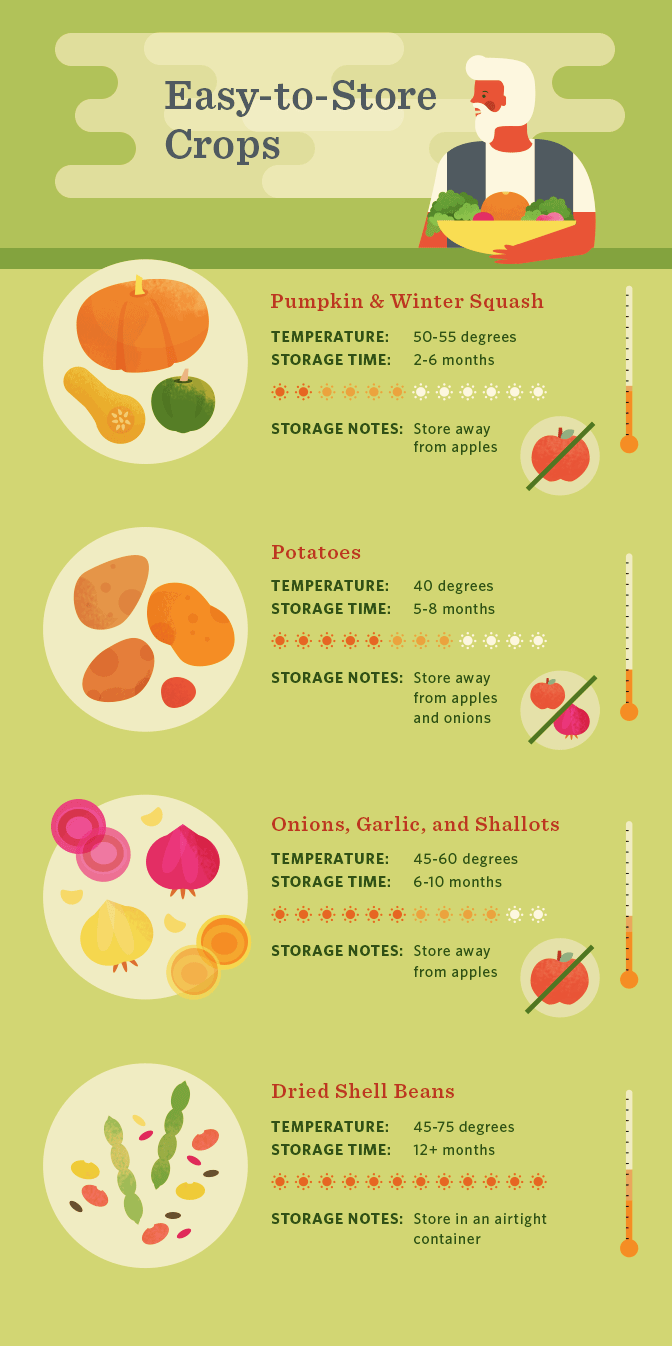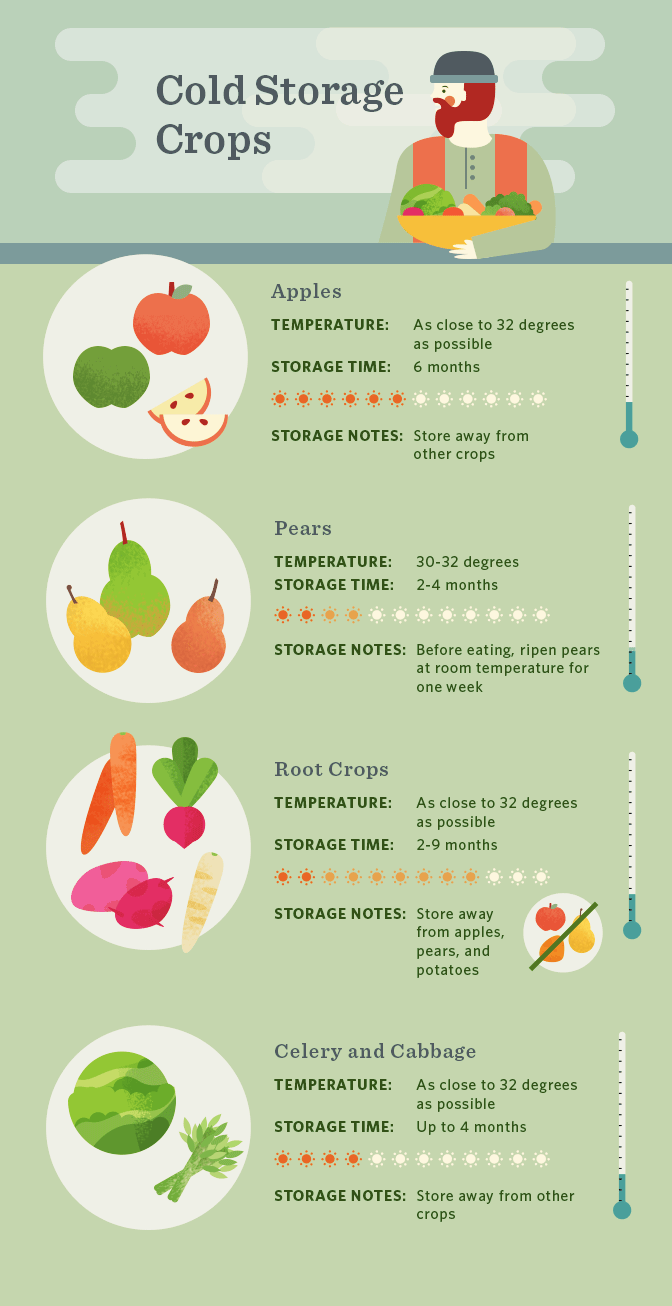Winter Storage Dos and Don’ts
For most of history, people were experts on food preservation because their lives depended on it. Around the turn of the twentieth century, electric refrigeration enabled people to transport food longer distances, sell it in modern supermarkets, and keep it cool at home. As a result, most of us never learned the low-tech food preservation skills once passed down in every culture.
For gardeners or those looking to eat more local foods, it is worth relearning some of those skills – especially winter food storage, the oldest and easiest method. Many fall crops can be safely stored and eaten over the winter months without the use of fancy canning equipment.
Our ancestors built root cellars, underground structures that kept food at a consistently cold temperature year round. Depending on individual needs, it may be worth building a root cellar or another type of food storage system if you don’t have ideal conditions to store winter crops. But before you start digging or building, it’s important to assess whether the chosen dwelling – probably a garage, shed, basement, cellar, or unheated room – already provides the ideal conditions for storing some food.
Easy-to-Store Crops
The following foods require a temperature of 45 to 60 degrees and low to moderate humidity. These conditions are often found in an attached garage, basement, attic, or unheated room.
Pumpkins and Winter Squash
Choose squash varieties that store well, such as buttercup or blue hubbard, and retain a three-inch stem. Cure homegrown varieties in a warm, sunny, ventilated place for one week. Then store the squash in ventilated boxes at 50 to 55 degrees and around 75 percent humidity. Garages and basements are often suitable. It’s better to store squash on a shelf rather than on a cold concrete floor. Depending on the variety, winter squash can keep for two to six months. Store them away from apples.
Onions, Garlic, and Shallots
Choose good keeper varieties, such as Copra onions and Purple Stripe or Ajo Rojo garlic. First cure homegrown varieties by spreading them on newspaper in a sunny, well-ventilated spot for one to three weeks until they’re dried out. Then store them in baskets, mesh bags, or paper bags punched with holes, in a cool, dry, well-ventilated place such as an attic, basement, or unheated room. They can keep for six to ten months. Store them away from potatoes, and never store in a refrigerator or in plastic.
Potatoes
Use late-variety crops, such as russet or Kennebec, for storage. Cure homegrown varieties by spreading them on newspaper and placing them in a dark place at 45 to 60 degrees for 10 to 14 days. The skins will thicken and toughen up. For storage, place them in cloth-covered baskets or ventilated boxes with a sheet of newspaper between each layer and on top. Keep them in a dark place that stays around 40 degrees with moderate humidity, such as the top shelf in a cellar or basement room. They can keep for five to eight months. Store away from onions and apples.
Dried Shell Beans
Harvest the pods when they’re dry on the vines and the beans rattle in the shell. Shell, sort, and store in dry, airtight containers in a cool, dry place (Mason jars work well). They can keep for one year or longer.
Cold-Storage Crops
The following crops keep longest at refrigerator-like temperatures between 32 and 40 degrees, and many need high humidity. This is where a hygrometer can come in handy. The most logical place to assess is the coldest part of the basement. Create humidity by introducing pans of water or damp burlap sacks, or by wetting an earthen floor. Or pack vegetables in a humid environment, like damp sand, sphagnum moss, or sawdust.
If a dwelling does not provide the right conditions, consider investing in an extra refrigerator to keep in an unheated basement or garage, or build one of the food storage systems described at the end of this article.
Apples
Choose late-season apples, such as Fuji, Winesap, or Granny Smith, for storage. Individually wrap each apple in paper and store in boxes or baskets lined with plastic with ventilation holes or foil to help retain moisture. Ideally, apples should be kept at 32 degrees; some varieties will keep for up to six months at that temperature. If storing apples in a refrigerator, create moisture by storing them in damp bags with ventilation holes. Apples should be stored away from many crops because they produce an ethylene gas that can harm other vegetables.
Pears
Choose winter pears, like D’Anjou or Winter Nellis. Pick the fruit when it’s still slightly immature, and cure at 40 to 50 degrees for a week. Then store in ventilated cardboard boxes in a place that will remain around 30 to 32 degrees. This could be an unheated shed, garage, or basement as long as the temperature never goes below 30 or above 45. If using a refrigerator, store in damp plastic bags with ventilation holes. Before eating, ripen pears by leaving them at room temperature for one week.
Root Vegetables
Root vegetables are either easy or tricky to store, depending on the climate. They need near-freezing conditions and high humidity. Where I live in western Oregon, the winters rarely go below freezing and the ground stays moist (to say the least), so I leave my carrots in the ground and harvest them all winter. I could do the same with parsnips, beets, turnips, rutabaga, storage radishes, and celeriac. If the temperature goes below freezing but stays above 10 degrees, mulch root vegetables with 6 to 18 inches of straw and leave them in the ground. Beware of rodents, though, who may be attracted to the straw and will happily munch on the produce.
For colder climates, one option is to store root vegetables in an extra refrigerator. To do this, harvest vegetables before the first hard freeze, cut the greens off with a sharp knife (leave a half-inch stub), put the roots in damp plastic bags with ventilation holes, and refrigerate. They can keep for several months this way.
To store roots without a refrigerator, pack them in buckets of damp sand, sphagnum moss, or sawdust, making sure the roots don’t touch each other. Store the buckets in an environment that stays consistently just above freezing. Root vegetables can keep for between two and nine months, depending on the variety. They should be stored away from apples, pears, and potatoes.
Celery and Cabbage
Like root vegetables, celery and cabbage can be left in the ground and harvested through the winter in mild climates. In colder climates, harvest cabbage before the first hard freeze when it is still slightly immature, and remove the outer leaves. Store in ventilated plastic bags in a refrigerator or packed in damp sand, sawdust, or sphagnum moss. Celery should be lifted out of the garden with its roots intact before the first hard freeze and transplanted into containers of damp sand. Keep both crops as close to 32 degrees as possible. They can keep up to four months and may be better stored away from other crops.
DIY Storage Systems
For those who are serious about winter food storage but don’t have the ideal conditions to store certain crops, it may be time to build a winter food storage system. Storage systems range from simple in-garden mounds to multi-room root cellars. For all of them, the key is to provide ventilation, monitor the temperature and humidity, and routinely inspect stored crops for spoilage.
Outdoor Storage Mounds: Depending on your storage needs and location, it’s possible to store small batches of potatoes, onions, leafy greens, or root vegetables in straw and dirt mounds built in the garden or another place with good drainage.
Outdoor Pits: Another option is to construct a simple root cellar by digging a deep hole, inserting a layer of rocks for drainage, and burying a trash can, a barrel tipped on its side, or a wooden box.
Insulated Corner of a Basement: If you have a basement, partition off and insulate a corner for fruit and vegetable storage.
Detached Root Cellar: Building a separate root cellar requires careful design, proper drainage and ventilation, and, depending on location, a permit. But it’s an unbeatable low-tech way to store large quantities of produce year-round.
Winter food storage doesn’t have to be complicated. It can be as simple as stocking away some extra onions and squash in a spare room. A little knowledge and attention now will keep fall’s bounty tasting delicious into the coming months.
Credit: http://www.fix.com/blog/keeping-your-harvest-year-round/














